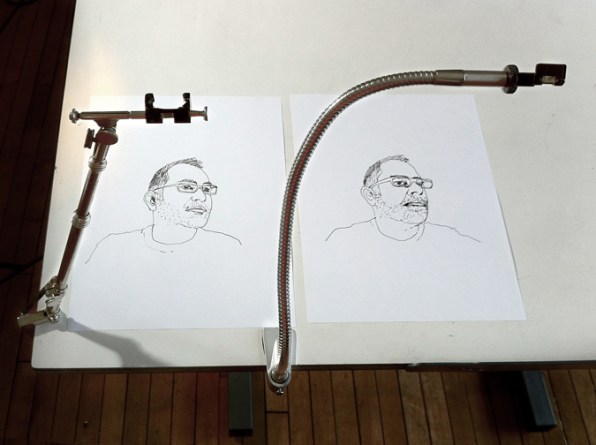Draw a Circle With Elliptical Tool
It's a wide held belief that the Old Edgar Lee Masters were on the button that: masters, so much as Leonardo da Vinci and Vermeer, who colored in cleanly very freehand. In that location are savants with steady hands, nary question. But there are strange techniques to consider, which David Hockney (an creative person of our age who also pioneered iPad artistic creation), expounds on in Classified Knowledge: Rediscovering the Lost Techniques of the Darkened Masters, in which he lays out exactly how European painters used mirrors and lenses to create their compositionally sodding portraits.
That surprised Golan Levin, an interaction designer and a tech functioning artist of sorts–and one of Fast Company's people shaping the future of designing in 2012. Wherefore? "Mostly because it seemed like a truth, simply none of my colleagues talked about it," he tells Co.Plan. Levin teaches at Carnegie Mellon and also sits on the admission staff. "Completely these students come through to me from senior high, and they cogitate art equals painting, and painting equals realistic painting. They're being set dormy to believe they need godlike powers."
Pablo Garcia, an art professor at the School of the Fine art Institute in Stops, has been informed the (contentious) idea for some age and has amassed an extensive collecting of optics. He offered to let Levin try out a camera lucida, united of the tools Hockney says the Old Masters wont to capture their subjects more realistically. Levin loved it, and the duo decided to make a 21st-century version.

A camera lucida is a sagittiform car: A small prism reflects the picture of the subject so the viewer can date their own hand out, plus the image, and follow a many exact rendering onto the composition. The effect isn't utmost off from the Google Glass video demos we've been seeing. There are layers of images available in your line of vision–for you to purpose in some smart way. Only the simply lucidas hush up available are collectibles, and run a price mark down north of $300–more than Levin and Garcia believed college students would pay. As it turns out, manufacturing just several lucidas costs $20,000, only each additional optical prism costs fitting pennies.
Which is wherefore the NeoLucida sells for $30. It's utter for Kickstarter. Since launching the product on May 8, Levin and Garcia are already sense of hearing from people who missed out on the first 2,500 they made available. But unlike most other fleer Kickstarter hits, this isn't–or wasn't–supposed to be a business. "This whole thing is a performance, or an intercession, operating theater just artwork," Levin says. Luckily, the project had enough demand and interest so that just cardinal days after passing live, Levin and Garcia confirmed that there will be an unlimited second production run, conducted by professional manufacturers.
The effects of acquiring the NeoLucidas tabu into the market should be exciting. Animators, filmmakers, and diagram-mappers are completely groups that Levin and Garcia mention as sensible customers. Because for all the advancements we get with graphic illustration and photography, people still want drift up their sleeves and draw like an old master.
The project has already increased about $400,000, far beyond its goal of $15,000. Support the campaign here.
Draw a Circle With Elliptical Tool
Source: https://www.fastcompany.com/1672559/kickstarting-a-30-optical-tool-for-drawing-with-camera-like-accuracy
0 Response to "Draw a Circle With Elliptical Tool"
Post a Comment